Top Rankings
Hollis-Brookline Cooperative School District ranks among the top 20% of public school district in New Hampshire for:
Category
Attribute
Overall Rank
Highest overall rank (Top 10%)
Math Proficiency
Highest math proficiency (Top 20%)
Reading/Language Arts Proficiency
Highest reading/language arts proficiency (Top 10%)
Graduation Rate
Highest graduation rate (Top 20%)
For the 2025 school year, there are 2 public schools serving 1,114 students in Hollis-Brookline Cooperative School District. This district's average testing ranking is 10/10, which is in the top 10% of public schools in New Hampshire.
Public Schools in Hollis-Brookline Cooperative School District have an average math proficiency score of 65% (versus the New Hampshire public school average of 41%), and reading proficiency score of 79% (versus the 51% statewide average).
Minority enrollment is 11% of the student body (majority Asian and Hispanic), which is less than the New Hampshire public school average of 18% (majority Hispanic).
Overview
This School District
This State (NH)
# Schools
2 Schools
508 Schools
# Students
1,114 Students
165,155 Students
# Teachers
98 Teachers
14,445 Teachers
Student : Teacher Ratio
11:1
11:1
District Rank
Hollis-Brookline Cooperative School District, which is ranked within the top 10% of all 189 school districts in New Hampshire (based off of combined math and reading proficiency testing data) for the 2021-2022 school year.
The school district's graduation rate of 94% has decreased from 97% over five school years.
Overall District Rank
#17 out of 189 school districts
(Top 10%)
(Top 10%)
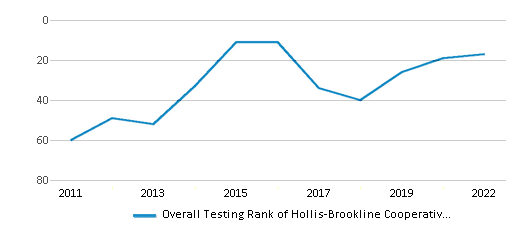
Math Test Scores (% Proficient)
64%
40%
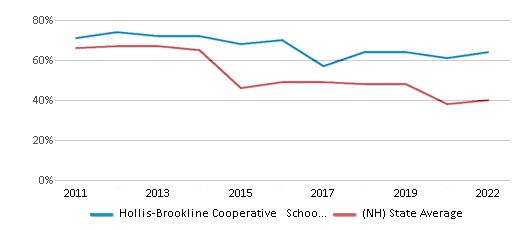
Reading/Language Arts Test Scores (% Proficient)
79%
51%
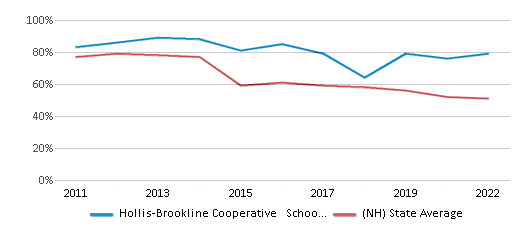
Science Test Scores (% Proficient)
41%
36%
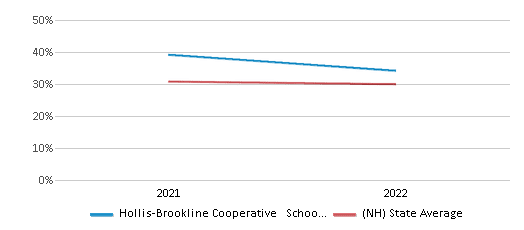
Graduation Rate
94%
88%

Students by Ethnicity:
Diversity Score
0.21
0.32
# American Indian Students
1 Student
308 Students
% American Indian Students
n/a
n/a
# Asian Students
49 Students
4,993 Students
% Asian Students
4%
3%
# Hispanic Students
38 Students
12,212 Students
% Hispanic Students
4%
8%
# Black Students
13 Students
3,437 Students
% Black Students
1%
2%
# White Students
987 Students
135,947 Students
% White Students
89%
82%
# Hawaiian Students
2 Students
133 Students
% Hawaiian Students
n/a
n/a
# Two or more races Students
24 Students
8,195 Students
% of Two or more races Students
2%
5%
Students by Grade:
# Students in PK Grade:
-
4,442
# Students in K Grade:
-
10,942
# Students in 1st Grade:
-
11,733
# Students in 2nd Grade:
-
12,179
# Students in 3rd Grade:
-
12,078
# Students in 4th Grade:
-
12,182
# Students in 5th Grade:
-
12,522
# Students in 6th Grade:
-
11,957
# Students in 7th Grade:
180
12,326
# Students in 8th Grade:
189
12,086
# Students in 9th Grade:
192
13,698
# Students in 10th Grade:
166
13,269
# Students in 11th Grade:
204
13,028
# Students in 12th Grade:
183
12,713
# Ungraded Students:
-
-
District Revenue and Spending
The revenue/student of $22,079 is higher than the state median of $22,075. The school district revenue/student has grown by 7% over four school years.
The school district's spending/student of $20,465 is less than the state median of $21,293. The school district spending/student has grown by 7% over four school years.
Total Revenue
$25 MM
$3,646 MM
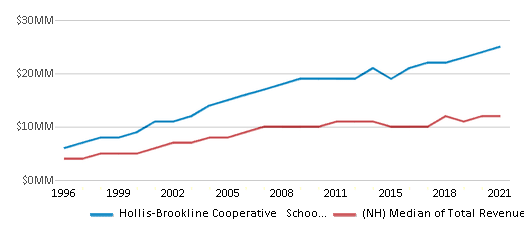
Spending
$23 MM
$3,517 MM
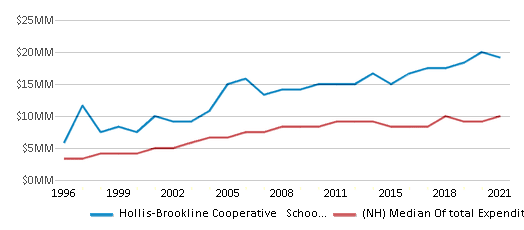
Revenue / Student
$22,079
$22,075
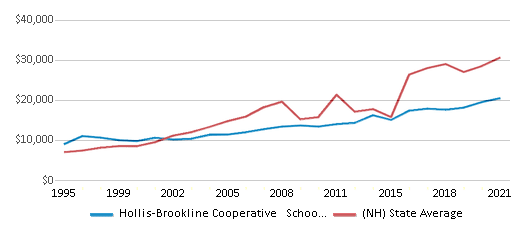
Spending / Student
$20,465
$21,293
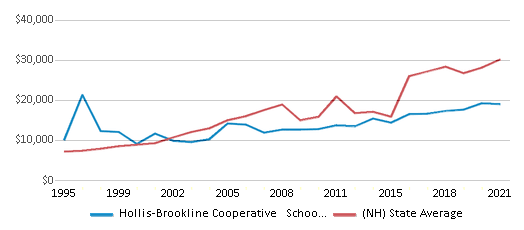
Best Hollis-Brookline Cooperative School District Public Schools (2025)
School
(Math and Reading Proficiency)
(Math and Reading Proficiency)
Location
Grades
Students
Rank: #11.
Hollis-brookline High School
(Math: 60-64% | Reading: 90-94%)
Rank:
Rank:
10/
Top 10%10
24 Cavalier Ct.
Hollis, NH 03049
(603) 465-2269
Hollis, NH 03049
(603) 465-2269
Grades: 9-12
| 745 students
Rank: #22.
Hollis-brookline Middle School
(Math: 66% | Reading: 72%)
Rank:
Rank:
10/
Top 10%10
25 Main St.
Hollis, NH 03049
(603) 324-5997
Hollis, NH 03049
(603) 324-5997
Grades: 7-8
| 369 students
Frequently Asked Questions
How many schools belong to Hollis-Brookline Cooperative School District?
Hollis-Brookline Cooperative School District manages 2 public schools serving 1,114 students.
What is the rank of Hollis-Brookline Cooperative School District?
Hollis-Brookline Cooperative School District is ranked #16 out of 189 school districts in New Hampshire (top 10%) based off of combined math and reading proficiency testing data for the 2021-2022 school year. This district ranks in the top 20% of New Hampshire school districts for: Highest overall rank (Top 10%), Highest math proficiency (Top 20%), Highest reading/language arts proficiency (Top 10%) and Highest graduation rate (Top 20%)
What is the racial composition of students in Hollis-Brookline Cooperative School District?
89% of Hollis-Brookline Cooperative School District students are White, 4% of students are Asian, 4% of students are Hispanic, 2% of students are Two or more races, and 1% of students are Black.
What is the student/teacher ratio of Hollis-Brookline Cooperative School District?
Hollis-Brookline Cooperative School District has a student/teacher ratio of 11:1, which is equal to the New Hampshire state average of 11:1.
What is Hollis-Brookline Cooperative School District's spending/student ratio?
The school district's spending/student of $20,465 is less than the state median of $21,293. The school district spending/student has grown by 7% over four school years.
Recent Articles

Year-Round Or Traditional Schedule?
Which is more appropriate for your child? A year-round attendance schedule or traditional schedule? We look at the pros and cons.

Why You Should Encourage Your Child to Join a Sports Team
Participating in team sports has a great many benefits for children, there is no doubt. In this article you will learn what those benefits are.

White Students are Now the Minority in U.S. Public Schools
Increasing birth rates among immigrant families from Asia and Central and South America, combined with lower birth rates among white families, means that for the first time in history, public school students in the United States are majority-minority. This shift in demographics poses difficulties for schools as they work to accommodate children of varying language abilities and socio-economic backgrounds.





